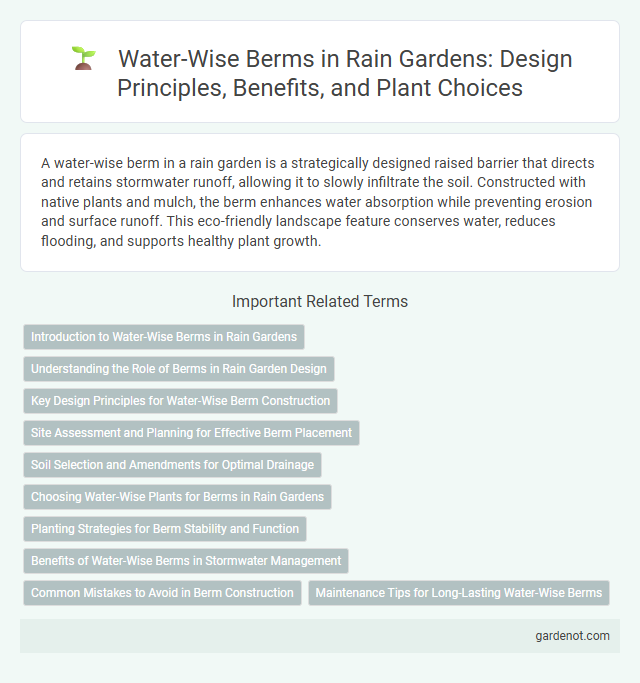A water-wise berm in a rain garden is a strategically designed raised barrier that directs and retains stormwater runoff, allowing it to slowly infiltrate the soil. Constructed with native plants and mulch, the berm enhances water absorption while preventing erosion and surface runoff. This eco-friendly landscape feature conserves water, reduces flooding, and supports healthy plant growth.
Introduction to Water-Wise Berms in Rain Gardens
Water-wise berms in rain gardens are strategically constructed mounds designed to enhance water retention and direct runoff towards planting areas. These berms, typically made from native soil and organic materials, promote efficient infiltration while preventing erosion and runoff loss. Incorporating water-wise berms supports sustainable landscaping by reducing stormwater impact and improving soil moisture levels for drought-tolerant plants.
Understanding the Role of Berms in Rain Garden Design
Water-wise berms play a critical role in rain garden design by directing and retaining runoff to maximize infiltration and reduce erosion. Constructed with compacted soil and native plants, berms create a barrier that slows water flow and encourages groundwater recharge. Properly designed berms enhance the efficiency of rain gardens by controlling water movement and supporting plant health.
Key Design Principles for Water-Wise Berm Construction
Water-wise berm construction prioritizes soil permeability, ensuring efficient water infiltration while preventing runoff. Incorporating native, drought-resistant plants on the berm stabilizes soil and maximizes water retention. Positioning the berm to capture runoff directs water toward the rain garden, enhancing overall stormwater management.
Site Assessment and Planning for Effective Berm Placement
Site assessment for water-wise berm placement includes analyzing soil permeability, slope gradient, and existing water flow patterns to ensure optimal water capture and infiltration. Proper planning incorporates positioning the berm parallel to contour lines to slow runoff and maximize water retention within the rain garden. Selecting native, drought-tolerant plants around the berm further enhances permeability and reduces erosion while supporting local biodiversity.
Soil Selection and Amendments for Optimal Drainage
Water-wise berm design prioritizes soil selection with well-draining, sandy loam to prevent waterlogging and promote healthy plant roots. Incorporating organic amendments like compost enhances soil structure, nutrient availability, and moisture retention while ensuring efficient drainage. Properly blended soil and amendments maximize rain garden performance by balancing water absorption and runoff control.
Choosing Water-Wise Plants for Berms in Rain Gardens
Selecting water-wise plants for berms in rain gardens enhances soil absorption and reduces runoff by using drought-tolerant species like sedum, ornamental grasses, and native wildflowers. These plants improve infiltration while requiring minimal irrigation, supporting sustainable stormwater management. Incorporating deep-rooted perennials and shrubs on berms stabilizes soil and promotes resilience in varying moisture conditions.
Planting Strategies for Berm Stability and Function
Water-wise berm planting strategies emphasize selecting deep-rooted native plants such as ornamental grasses, sedges, and wildflowers to enhance soil stability and promote effective water infiltration. Incorporating layered vegetation with varying root depths reduces erosion risks and supports diverse microhabitats within the berm structure. Strategic plant placement on the berm's slope optimizes stormwater retention and minimizes surface runoff, ensuring sustainable rainfall management in rain garden systems.
Benefits of Water-Wise Berms in Stormwater Management
Water-wise berms enhance stormwater management by directing and slowing runoff, facilitating groundwater recharge and reducing erosion. These berms promote water infiltration, increase pollutant filtration, and minimize surface water pollution in urban and suburban landscapes. Integrating vegetation in berms further supports habitat creation and improves the overall ecological health of rain gardens.
Common Mistakes to Avoid in Berm Construction
A common mistake in water-wise berm construction is failing to compact the soil properly, which can lead to erosion and structural instability. Overlooking the importance of establishing proper slope gradients often results in poor water diversion and pooling, undermining the berm's effectiveness. Using inappropriate soil types without adequate organic matter reduces water retention and plant health, compromising the rain garden's overall performance.
Maintenance Tips for Long-Lasting Water-Wise Berms
Regular inspections ensure water-wise berms maintain proper shape and function, preventing erosion and water pooling. Applying mulch conserves moisture, suppresses weeds, and promotes healthy plant growth vital for berm stability. Pruning and replacing damaged vegetation enhance water absorption and preserve the berm's structural integrity over time.
Water-wise berm Infographic

 gardenot.com
gardenot.com